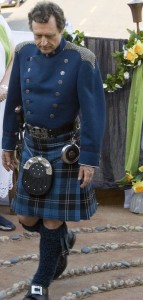 Paganism inherently demands that each individual seek their own path of knowledge, discover their own truth, become their own spiritual authority. These autonomous seekers are generally free spirits and iconoclasts who question everything and accept nothing until they have discovered it within their own hearts and consciousness. They have an unquenchable thirst for knowledge and enlightenment. Pagans are not generally dictated by culture or tradition, but seek out the commonalities which lie at the foundation of all. They believe at the core of these commonalities lies the heart, the essence of oneness.
Paganism inherently demands that each individual seek their own path of knowledge, discover their own truth, become their own spiritual authority. These autonomous seekers are generally free spirits and iconoclasts who question everything and accept nothing until they have discovered it within their own hearts and consciousness. They have an unquenchable thirst for knowledge and enlightenment. Pagans are not generally dictated by culture or tradition, but seek out the commonalities which lie at the foundation of all. They believe at the core of these commonalities lies the heart, the essence of oneness.
While not exclusive to Paganism, the emphasis on self-awareness, personal responsibility, and spiritual autonomy requires that each person discover, experience, and seek out the truth for themselves. This challenge of self-realization empowers the individual to go beyond any limits previously known. The spiritual autonomy which has been a core value of Pagan heritage has also limited Pagans from reaping any of the benefits accorded most other spiritual traditions.
Pagans are a large and widely-varied group
spanning the globe, expansive in their
diversity and pluralism.
For many centuries, Pagans have for the most part stayed in the shadows and intentionally steered away from codification and legalization, preferring to celebrate the agricultural cycles of the Earth in the safety of a living room or a backyard under a full moon. Hence, it has continued to be not only a very misunderstood religion, but a religion that often evokes fear in people of other religious beliefs.
So who are Pagans and why have they chosen to stay hidden? To understand the fears that have compelled these Earth-based spiritual believers to remain in the shadows; to shy away from being seen through a legal lens that could possibly unite them; or to codify the essence of their beliefs, non-Pagans will need to understand the path of death and destruction that is the Pagan legacy. For more understanding, please read the “The Goddess Underground” from the Temple of the Goddess Handbook.
My life’s work has been to not only dispel the fear and misinformation surrounding Paganism but to legitimize, to some extent, Earth-based religions by codifying the common tenets of our beliefs as well as acquiring U.S. federal recognition as a Pagan church. These common Pagan tenets include a reverence for the Earth and nature. The philosophy of Immanence–the belief that the world, the cosmos, and everything in it is alive and connected–is a commonly held Pagan belief. We also honor each person as their own spiritual authority. These are just a few of the common threads that create the multi-hued, magnificent tapestry which is Paganism. The term Paganism can be seen as an over-arching umbrella much like the term Christianity. The analogy can be made that under the panoptic banner of Christianity can be found many branches of faith such as Catholic, Methodist, Anglican, Baptist, to name a few. Just as under the uniting appellation of Paganism, many multi-hued expressions of Earth-honoring spiritual traditions can be found such as Goddess, Druid, Wicca, even the beliefs of many indigenous peoples around the world.
The process of becoming one of only a handful of nonprofit Pagan temples in the U.S. was not an easy path. Nor was the challenge of attempting codification of some basic Pagan principles. Both feats required tenacity, hard work, and great humility. Legalizing and codifying what many, both Pagans and non-Pagans, believe should never be done, means shining a light on ourselves, being seen and recognized publicly. This evokes a wide range of emotions and action from both sides of the fence. Many, maybe even most, Pagans truly believe that to “set beliefs in stone” translates to dictating law and loss of spiritual autonomy.
On the other side of the spectrum, being recognized publicly evokes visceral opposition from believers in traditional religions. Many of these religious followers adhere to the limiting belief that there is only one way, one thought, one belief, with each of these mainstream religions believing they have a unique claim on the truth. This path has led to the slaughter of millions of people in the name of god and religion. Even in these modern times, Pagans experience the whiplash of fear and hate from people and groups whose beliefs inherently dictate this notion that there is only one way of experiencing the divine.
The guiding principles of Temple of the Goddess are just that: guiding principles. Not commandments. The intention of creating these principles, asking What Is Religion?, What Is Paganism?, distilling some of the history of divine feminine, is not meant to distance or alienate, but to bring to the world an understanding of the living, thriving, evolving, dynamic, and ancient spiritual tradition known as Paganism.



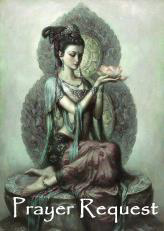
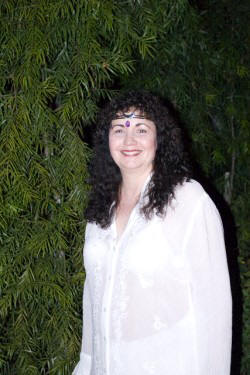 For almost two decades Rev. Xia has walked the path of the divine feminine, committed to her role as an inter-faith ambassador for the Pagan Community. Among her many articles, an essay entitled Paganism: Out of the Closet and into the Fire, originally written for her son’s school in Pasadena for a Diversity in Religion series, has been reprinted countless times. Additionally, she has written numerous mythological and ritual works centered around archetypal studies of the Goddess including Rites of Passage: A Goddess Ritual for Women, which aired on The Learning Channel–showing Pagan rites for Maiden, Mother, and Crone. She also produced and facilitated that segment for The Learning Channel. Additional articles include: Ritual and the Art of Alchemy, The Mythology of Nature, The Legacy of Creation Myths, The Myth of Matriarchy, and Secret Garden of the Feminine. She is completing a non-fiction book entitled, Feminine Alchemy: The Ritual Art of Cooking, a book of healing through Goddess archetypes which has been on the back burner for many years.
For almost two decades Rev. Xia has walked the path of the divine feminine, committed to her role as an inter-faith ambassador for the Pagan Community. Among her many articles, an essay entitled Paganism: Out of the Closet and into the Fire, originally written for her son’s school in Pasadena for a Diversity in Religion series, has been reprinted countless times. Additionally, she has written numerous mythological and ritual works centered around archetypal studies of the Goddess including Rites of Passage: A Goddess Ritual for Women, which aired on The Learning Channel–showing Pagan rites for Maiden, Mother, and Crone. She also produced and facilitated that segment for The Learning Channel. Additional articles include: Ritual and the Art of Alchemy, The Mythology of Nature, The Legacy of Creation Myths, The Myth of Matriarchy, and Secret Garden of the Feminine. She is completing a non-fiction book entitled, Feminine Alchemy: The Ritual Art of Cooking, a book of healing through Goddess archetypes which has been on the back burner for many years. My specific Priestess Path I wish to dedicate myself to is sacred circles. This means that my truest spiritual ecstasy comes from ritual in community with others. This is a large circle that includes not only planning and performing ritual, but also creating ritual art such as building altars, teaching ritual, making video…
My specific Priestess Path I wish to dedicate myself to is sacred circles. This means that my truest spiritual ecstasy comes from ritual in community with others. This is a large circle that includes not only planning and performing ritual, but also creating ritual art such as building altars, teaching ritual, making video…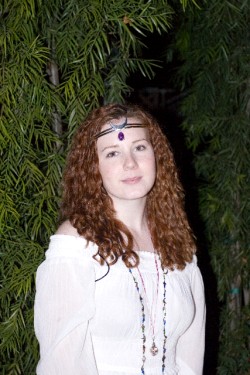 Marcella, our youngest priestess, has been a professional actor for many years. She is a graduate of the Los Angeles County High School for the Arts. Other training includes Viewpoints/Suzuki with Anthony Byrnes, Voice-Over Workshops with Sharon Mack, and the Royal Academy of Dramatic Arts in London, a Shakespeare Intensive. Her theater credits include The Cherry Orchard, A Midsummer Night’s Dream, and The Wizard of Oz. Her film credits include, Punch-Drunk Love, A Host of Trouble, and Kids in America. She has co-starred on various television shows, such as NCIS, Boston Legal, The O’Keefe’s, and Malcolm in the Middle. Awards encompass 1st Place in the 2005 and 2006 DTASC Shakespeare Competition / monologue, 1st Place 2005 RoleAbout / Cold Reading, 1st Place 2005 RoleAbout / Classical Monologue, and was the Silver Medalist ROP Outstanding Student in TV/Film.
Marcella, our youngest priestess, has been a professional actor for many years. She is a graduate of the Los Angeles County High School for the Arts. Other training includes Viewpoints/Suzuki with Anthony Byrnes, Voice-Over Workshops with Sharon Mack, and the Royal Academy of Dramatic Arts in London, a Shakespeare Intensive. Her theater credits include The Cherry Orchard, A Midsummer Night’s Dream, and The Wizard of Oz. Her film credits include, Punch-Drunk Love, A Host of Trouble, and Kids in America. She has co-starred on various television shows, such as NCIS, Boston Legal, The O’Keefe’s, and Malcolm in the Middle. Awards encompass 1st Place in the 2005 and 2006 DTASC Shakespeare Competition / monologue, 1st Place 2005 RoleAbout / Cold Reading, 1st Place 2005 RoleAbout / Classical Monologue, and was the Silver Medalist ROP Outstanding Student in TV/Film.
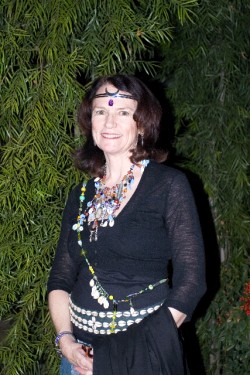 I have been following the path of the goddess for over 30 years. As an artist, I have always been interested in the mutual influence between the personal and political, private and communal, spiritual and artistic expression.
I have been following the path of the goddess for over 30 years. As an artist, I have always been interested in the mutual influence between the personal and political, private and communal, spiritual and artistic expression.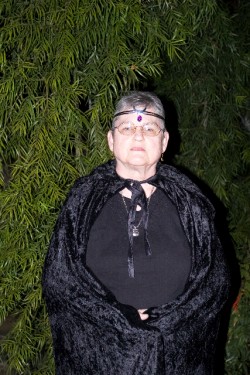 God was strictly male in the forties. And the males in my life were minor demi-gods to be obeyed without question. Father, priests, especially Monsignor, policemen, doctors–they protected me, taught me, molded me. My teachers (grade and high school) were Catholic nuns, but they were under the supervision and control of the priesthood.
God was strictly male in the forties. And the males in my life were minor demi-gods to be obeyed without question. Father, priests, especially Monsignor, policemen, doctors–they protected me, taught me, molded me. My teachers (grade and high school) were Catholic nuns, but they were under the supervision and control of the priesthood.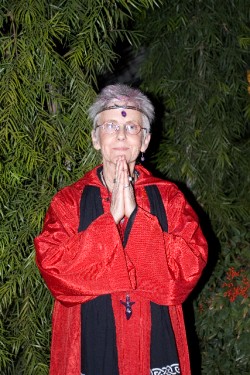 Introduction—the beginning February, 1986
Introduction—the beginning February, 1986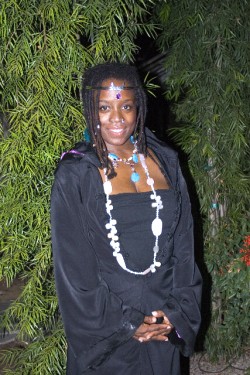 Haize Rosen has worked professionally as an actress, dancer and choreographer for 20 years. Haize is also an energy-light worker, certified in Thai massage and Hellerwork. To complement her work in the healing arts, Haize is a certified assistant mid-wife, and has a thriving doula practice. As a dancer, Haize has studied Balinese, The Orishas of both Africa and Brazil, and Classical Indian Dance in the style of Odissi. She has choreographed such renowned musicals as Guys and Dolls, Fiddler on the Roof, Little Shop of Horrors, and Grease. Haize recently wrote and starred in her one-woman shop, Country Colored Girl, which chronicled her family history in a small town in Alabama. She has studied ballet with Joy Finch, and acting at Lee Strausberg. Haize has worked rehabbing children at Juvenile Hall and taught theater and dance professionally in workshops throughout Los Angeles. The ordination onto her Priestess path in Temple of the Goddess is a culmination of her life’s work and provides an opportunity for Haize to apply her knowledge and skills in new and effective ways in the world.
Haize Rosen has worked professionally as an actress, dancer and choreographer for 20 years. Haize is also an energy-light worker, certified in Thai massage and Hellerwork. To complement her work in the healing arts, Haize is a certified assistant mid-wife, and has a thriving doula practice. As a dancer, Haize has studied Balinese, The Orishas of both Africa and Brazil, and Classical Indian Dance in the style of Odissi. She has choreographed such renowned musicals as Guys and Dolls, Fiddler on the Roof, Little Shop of Horrors, and Grease. Haize recently wrote and starred in her one-woman shop, Country Colored Girl, which chronicled her family history in a small town in Alabama. She has studied ballet with Joy Finch, and acting at Lee Strausberg. Haize has worked rehabbing children at Juvenile Hall and taught theater and dance professionally in workshops throughout Los Angeles. The ordination onto her Priestess path in Temple of the Goddess is a culmination of her life’s work and provides an opportunity for Haize to apply her knowledge and skills in new and effective ways in the world. 

